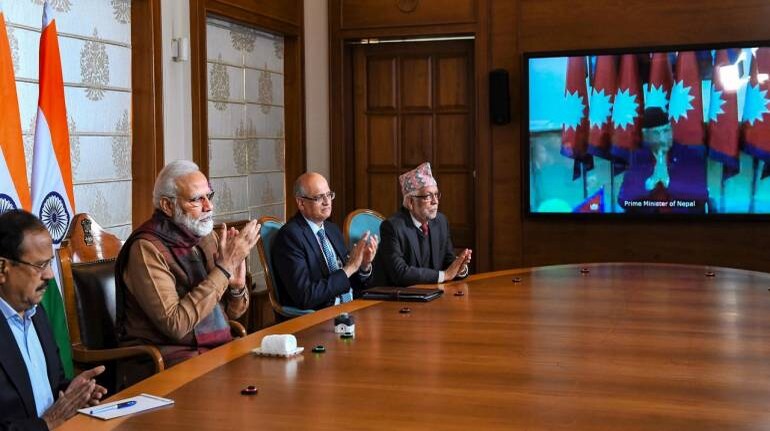
Last week, the Nepalese government released a new map of the country which included Kalapani at the India-Nepal-Tibet tri-junction as part of its territory, drawing immediate protest from India. Administered by the latter as part of Uttarakhand, the area has been a bone of contention for several decades now between Nepal and India.
In November 2019, Kathmandu chose the occasion of the release of new Indian maps to reflect the reorganisation of Jammu and Kashmir, to register fresh protests over the depiction of Kalapani as Indian territory.
The trigger for the present Nepalese action seems to be the inauguration by Defence Minister Rajnath Singh of an approximately 90km-long new road across Kalapani to the Lipulekh Pass. This route is one of the two in India used for the annual pilgrimage to Kailash Mansarovar in Tibet. The other route through Nathu La in Sikkim was hitherto the only one with a proper road, while the Lipulekh route involved an arduous three-week trek. With the new road, travel time from Delhi comes down to three days.
The Nepalese action has been attributed to the domestic political compulsions of Nepalese Prime Minister KP Oli, including divisions within his ruling Nepal Communist Party. Whatever the reason, it raises considerably the difficulty of India and Nepal resolving the matter through diplomacy.
This has then led to other statements from the Indian side about a possible Chinese hand in the whole episode. Indian Army Chief General MM Naravane left nothing to the imagination when, in a statement on May 15, he declared that that the Nepalese protest against the road might have been raised “at the behest of someone else”. Of course, he was also speaking following Chinese transgressions across the disputed India-China boundary in Ladakh as well as their settled boundary in Sikkim.
China’s influence in Nepal has grown in recent years. The most visible demonstration has been its involvement in the development of religious and tourist facilities in Lumbini, the birthplace of Lord Buddha. However, there have been other equally important moves, including active Chinese economic support for and engagement with Nepal’s northern border districts, increasing cooperation between Nepalese and Chinese border police that has resulted in reducing the numbers of Tibetans fleeing Chinese rule to practically a trickle, and a cross-border optical fibre link in Kathmandu, providing an alternate Internet gateway through China in addition to those through India.
In some instances, the Chinese have merely stepped into breaches created either by India’s inability to keep its promises or by its insensitivity. For instance, the Indians promised the Nepalese a police training academy in 1995. This is yet to see the light of day while a training academy for Nepal’s paramilitary Armed Police Force funded by the Chinese saw construction start in 2015 and finish in less than two years.
Similarly, a railway line from India to Kathmandu had been talked about decades before the Chinese began talking about plans to connect Lhasa with Kathmandu by rail. This might yet be a difficult project to complete but China’s successes in getting its railways to Tibet and close to the border with Nepal in the space of little over a decade inspires greater confidence.
Indian government officials, both current and past, have a point when they say that anti-India sentiment in Nepal is often based on unfounded fears and unreasonable expectations, and whipped up to meet political exigencies by one or the other of Nepal’s political players. That said, New Delhi could learn to speak less as if the Nepalese do not have agency of their own or, indeed, cannot have genuine concerns and complaints that they might not want to settle on what they perceive as India’s terms or on the basis of strict reciprocity.
To keep Nepal on its side is in India’s interests, especially in the face of a rising Chinese presence in South Asia. This presence is not just economic and military, but increasingly involves strong political commitment. In September, the Communist Party of China conducted a training programme on governance practices in China for Oli’s ruling NCP. The political implications of this Chinese outreach in India’s immediate neighbourhood have been highlighted before. In the latest instance, it was reported at the beginning of May that the Chinese ambassador in Kathmandu Hou Yanqi had met with senior functionaries of the Nepalese ruling party to encourage them to end their infighting.
The COVID-19 pandemic has created additional complications in the triangular relationship.
In late March, the presence of Chinese workers at a dam site in Lamjung in Nepal led to clashes with locals angry over the former violating lockdown conditions. Earlier in February, a group of 17 editors of Nepalese dailies and online portals criticised the Chinese embassy for “disparagement and threats” against the Kathmandu Post’s editor-in-chief for republishing an article by a former American diplomat about China’s cover-up of the Coronavirus outbreak.
Oli has chosen, however, to target India by stating in his country’s parliament — a day after the new map was released — that the “Indian virus” was “more lethal” than the virus from Wuhan and blaming those arriving from India “without proper checking” for the further cases in Nepal. Not for the first time, Oli has chosen to speak and present his country’s position in ways that aid Chinese propaganda and support Beijing’s political interests.
In addition to dealing with military challenges on the LAC, therefore, New Delhi will need to find ways to deal with indirect challenges posed by increasing Chinese political influence in South Asia.
Jabin T Jacob is Associate Professor, Department of International Relations and Governance Studies, Shiv Nadar University, Uttar Pradesh and Adjunct Research Fellow at the National Maritime Foundation, New Delhi. Twitter: @jabinjacobt. Views are personal.
Discover the latest business news, Sensex, and Nifty updates. Obtain Personal Finance insights, tax queries, and expert opinions on Moneycontrol or download the Moneycontrol App to stay updated!